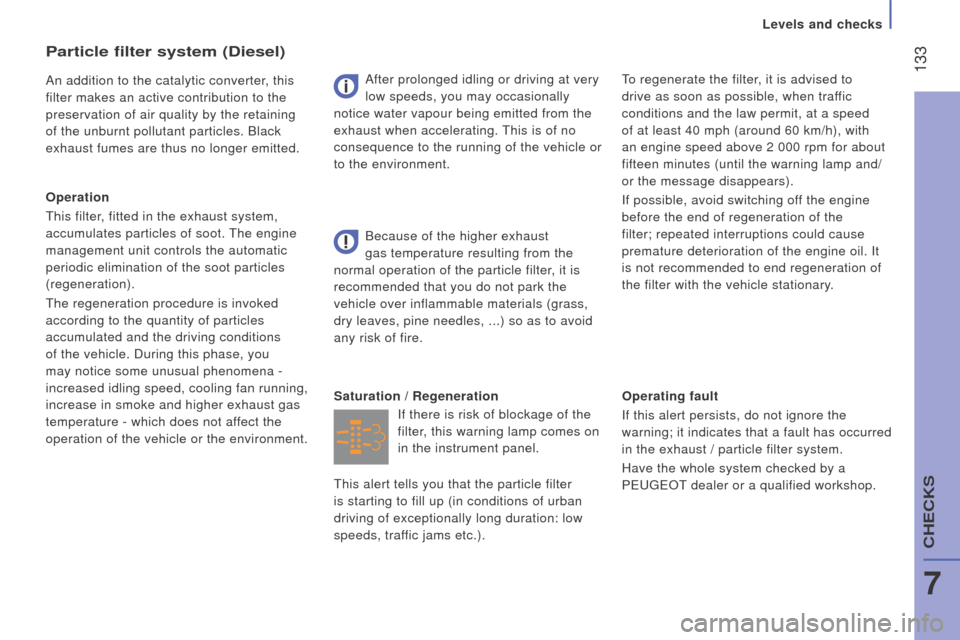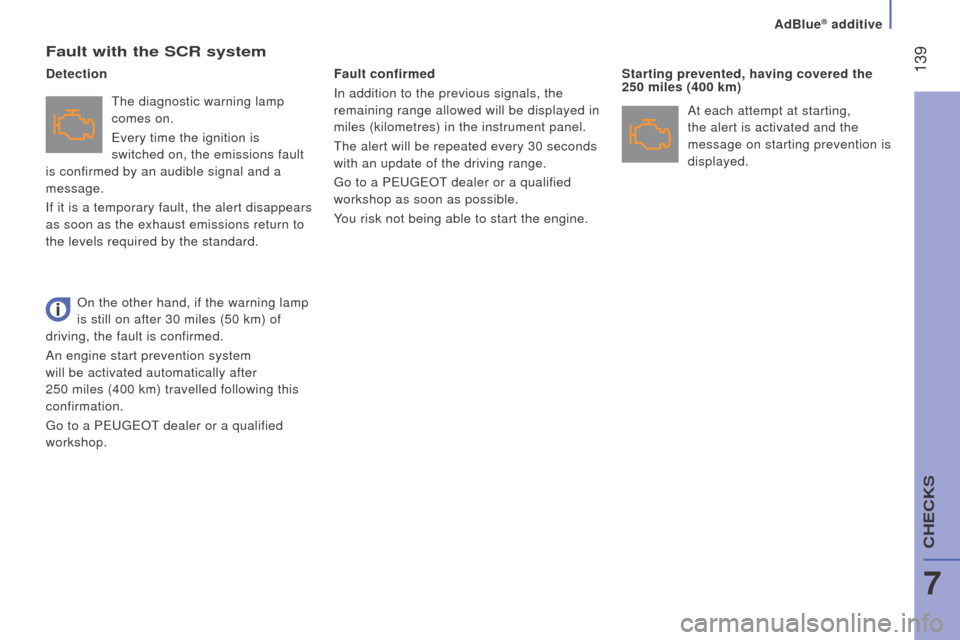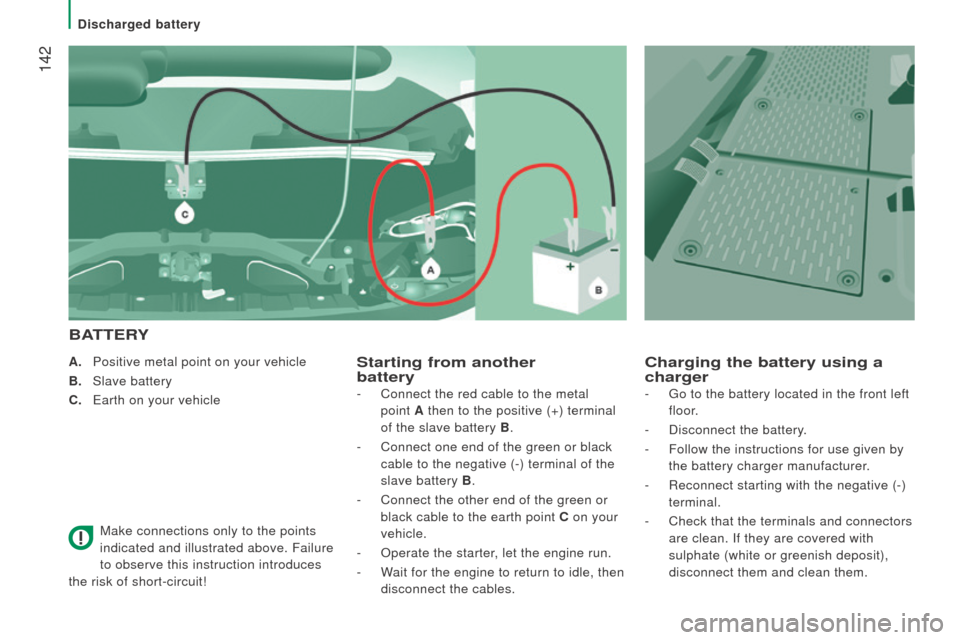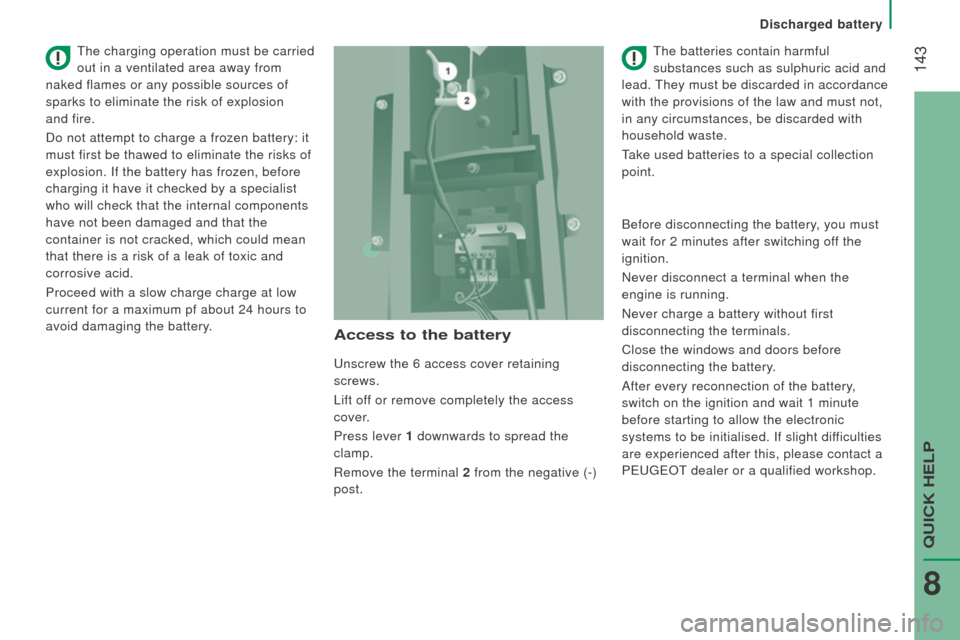check engine Peugeot Boxer 2016 Owner's Guide
[x] Cancel search | Manufacturer: PEUGEOT, Model Year: 2016, Model line: Boxer, Model: Peugeot Boxer 2016Pages: 292, PDF Size: 10.07 MB
Page 131 of 292

129
boxer_en_Chap07_Verifications_ed01-2015
used products
Avoid prolonged contact of used oil or fluids
with the skin.
Most of these fluids are harmful to health or
indeed very corrosive.
Do not discard used oil or fluids into sewers
or onto the ground.
take used oil to a P
euge O t
dealer or
a qualified workshop (France) or to an
authorised waste disposal site.
LEVELS
these regular maintenance operations
will keep your vehicle in good running
order. Ask for advice at a P
euge O t
dealer
or consult the warranty and maintenance
record contained in the handbook pack.
to maintain the reliability of engines and
emission control systems, the use of
additives in engine oil is prohibited.
changing the brake fluid
the brake fluid must be changed at
the intervals stated, according to the
manufacturer's servicing schedule.
u
se fluids recommended by the
manufacturer, which fulfil DO
t 4 standards.
t
he level must be between the MI n and
MA
x marks on the reservoir.
If fluid has to be added frequently, this
indicates a failure which must be checked by
a P
euge O t
dealer or a qualified workshop
as soon as possible.
If you have to remove/refit the engine
styling cover, handle it with care to
avoid damaging the fixing clips.
d
ipstickt
here are two marks on
the dipstick:
o
il change
It is imperative that this is carried out at the
intervals specified in the manufacturer's
servicing schedule. Ask for advice at at
P
euge
O
t
dealer
.
Remove the dipstick before filling.
Check the level after filling (never exceed
the maximum mark).
Screw the cap back onto the sump before
closing the bonnet.
Viscosity selection
When topping-up, the oil selected must meet
the manufacturer's requirements.
Warning lamps
Checking by means of the warning
lamps on the instrument panel is
described in the "Ready to set off -
Instruments and controls" section.
A
= maximum
If you fill past this mark,
contact a P
euge
O
t
dealer or a qualified
workshop.
B = minimum
Never allow the level to fall
below this mark.
oil level
Check the level regularly and top up
between changes.
t
he maximum
consumption is 0.5 litre per 600 miles
(1 000
km). Check the level with the vehicle
level, engine cold, using the dipstick.
Levels and checks
7
CHeCKS
Page 132 of 292

130
boxer_en_Chap07_Verifications_ed01-2015
cooling systemPower steering fluid level
the vehicle must be parked on level ground
with the engine cold. u nscrew the cap
integrated with the gauge and check the
level which must be between the MI
n and
MA
x marks.
For access to the reservoir filler cap, remove
the protective cover by turning its three
fixing screws a quarter turn, then remove the
second cover fitted to the cap.
topping up
t
he level must be between the MI n and
MA x marks on the expansion bottle. If
more than 1 litre of fluid is required to top
up the level, have the system checked by a
P euge O t
dealer or a qualified workshop.
Windscreen wash and headlamp
wash level
Capacity of the reservoir: approximately
5.5
litres.
For access to the reservoir filler cap, pull on
the telescopic filler pipe and unclip the cap.
For best quality cleaning and to prevent
freezing, this fluid must not be topped up or
replaced with plain water.
In wintry conditions, the use of an alcohol or
methanol based fluid is recommended.
If fluid has to be added frequently, this
indicates a failure which must be checked by
a P
euge
O
t dealer or a qualified workshop
as soon as possible.
Only use the fluid recommended by the
manufacturer. Otherwise, you risk seriously
damaging your engine. When the engine
is warm, the temperature of the coolant is
controlled by the engine fan. As this fan can
operate with the ignition key removed and
because the cooling system is pressurised,
wait for at least one hour after the engine
has stopped before carrying out any work.
Slacken the cap by 1/4 of a turn to release
the pressure to prevent any risk of scalding.
When the pressure has dropped, remove the
cap and top up the level with coolant.
For access to the header tank filler cap,
remove the protective cover by turning its
three fixing screws a quarter turn.
Levels and checks
Page 133 of 292

131
boxer_en_Chap07_Verifications_ed01-2015
the presence of this label, in particular with
the Stop & Start system, indicates the use of
a specific 12
V lead-acid battery with special
technology and specification. The involvement
of a PEUGEOT dealer or a qualified workshop
is essential when replacing or disconnecting
the battery.
t
hese operations will keep your vehicle
in good running order. Ask for advice
from a P euge O t
dealer or refer to the
warranty and maintenance record included
in the handbook pack.
cHEcKS
Battery
At the start of winter, have your battery
checked by a P euge O t
dealer or a
qualified workshop.
Bleeding water from the diesel
filter
If this warning lamp comes on,
bleed the filter, or bleed regularly
each time the engine oil is
changed.
to drain the water out, unscrew the bleed
screw or the water in Diesel sensor, located
at the base of the filter. Leave open until
all of the water has been drained out.
t
hen
tighten the bleed screw or the water sensor.
Air filter and passenger
compartment filter
A clogged passenger compartment filter
may reduce the performance of the
air conditioning system and generate
undesirable odours.
t
he replacement
intervals for these components are given in
the warranty and maintenance record.
Depending on the environment (dusty
atmosphere...) and the use of the vehicle
(urban driving...), change them twice as
often if necessary.
Refer to the "Checks -
u nder the
bonnet" section.
HDi engines use advanced technology.
All work requires a special qualification
which is guaranteed by a P
euge
O
t
dealer
or a qualified workshop.
Levels and checks
7
CHeCKS
Page 134 of 292

132
boxer_en_Chap07_Verifications_ed01-2015
Manual gearbox
Have the level checked in accordance with
the manufacturer's servicing schedule.
Good practiceo
il filter
Brake pads
Brake pad wear depends on the style of
driving, in particular for vehicles which are
used in town, over short distances. It may
be necessary to check the thickness of the
pads, even between services.
Brake disc wear
For any information on checking the brake
disc wear, contact a P euge O t
dealer or a
qualified workshop.
Parking brake
Where the parking brake travel is too great
or there is a reduction in the performance
of the system, the parking brake should be
adjusted, even between services.
Have the system checked by a P
euge O t
dealer or a qualified workshop.
If this warning lamp comes on,
have the brake pad wear checked
by a P
euge
O
t
dealer or a
qualified workshop. In order to avoid damaging the
electrical units, we strongly advise you
not to use high pressure washing to clean
the engine compartment.
After washing the vehicle dampness, or in
winter, ice may form on the brake discs and
pads: braking efficiency may be reduced.
Make some light brake applications to dry
and de-ice the brakes. Only use products recommended by
P euge O t
or products of equivalent quality
and specification.
In order to optimise the operation of units as
important as the braking system, P euge O t
selects and of
fers specific products.
Change the filter regularly, in accordance
with the manufacturer's servicing schedule.
Levels and checks
Page 135 of 292

133
boxer_en_Chap07_Verifications_ed01-2015
operating fault
If this alert persists, do not ignore the
warning; it indicates that a fault has occurred
in the exhaust / particle filter system.
Have the whole system checked by a
P
euge O t
dealer or a qualified workshop.
If there is risk of blockage of the
filter, this warning lamp comes on
in the instrument panel.
Saturation /
r
egeneration
Because of the higher exhaust
gas temperature resulting from the
normal operation of the particle filter, it is
recommended that you do not park the
vehicle over inflammable materials (grass,
dry leaves, pine needles,
...) so as to avoid
any risk of fire.
Particle filter system (diesel)
An addition to the catalytic converter, this
filter makes an active contribution to the
preservation of air quality by the retaining
of the unburnt pollutant particles. Black
exhaust fumes are thus no longer emitted.
o
peration
t
his filter, fitted in the exhaust system,
accumulates particles of soot.
t
he engine
management unit controls the automatic
periodic elimination of the soot particles
(regeneration).
t
he regeneration procedure is invoked
according to the quantity of particles
accumulated and the driving conditions
of the vehicle. During this phase, you
may notice some unusual phenomena
-
increased idling speed, cooling fan running,
increase in smoke and higher exhaust gas
temperature
- which does not affect the
operation of the vehicle or the environment. After prolonged idling or driving at very
low speeds, you may occasionally
notice water vapour being emitted from the
exhaust when accelerating.
t
his is of no
consequence to the running of the vehicle or
to the environment.to regenerate the filter , it is advised to
drive as soon as possible, when traffic
conditions and the law permit, at a speed
of at least 40
mph (around 60 km/h), with
an engine speed above 2 000 rpm for about
fifteen
minutes (until the warning lamp and/
or the message disappears).
If possible, avoid switching off the engine
before the end of regeneration of the
filter; repeated interruptions could cause
premature deterioration of the engine oil. It
is not recommended to end regeneration of
the filter with the vehicle stationary.
t
his alert tells you that the particle filter
is starting to fill up (in conditions of urban
driving of exceptionally long duration: low
speeds, traffic jams etc.).
Levels and checks
7
CHeCKS
Page 137 of 292

135
boxer_en_Chap07_Verifications_ed01-2015
FuEL SYS t EM cut-o FF
Following an impact and before
restoring the supply, check that there is
no leak of fuel or sparks so as to avoid any
risk of fire. In the event of a collision, a device
automatically cuts off the fuel supply to the
engine and the vehicle's electrical supply.
It switches on the hazard warning lamps and
the courtesy lamps, as well as unlocking the
doors.
to restore the fuel supply
, press the first
button located under the glove box.t hen, to restore the electrical power supply,
press the second button, located in the
battery compartment under the driver's floor
(Minibus).
On other versions the second button
is replaced by a fuse; contact a
P
euge O t
dealer or a qualified workshop.
Fuel
7
CHeCKS
Page 141 of 292

139
boxer_en_Chap07_Verifications_ed01-2015
Fault with the Scr system
the diagnostic warning lamp
comes on.
e
very time the ignition is
switched on, the emissions fault
is confirmed by an audible signal and a
message.
If it is a temporary fault, the alert disappears
as soon as the exhaust emissions return to
the levels required by the standard. Fault confirmed
In addition to the previous signals, the
remaining range allowed will be displayed in
miles (kilometres) in the instrument panel.
t
he alert will be repeated every 30 seconds
with an update of the driving range.
g
o to a P euge O t
dealer or a qualified
workshop as soon as possible.
You risk not being able to start the engine. Starting prevented, having covered the
250 miles (400 km)
d
etection
At each attempt at starting,
the alert is activated and the
message on starting prevention is
displayed.
On the other hand, if the warning lamp
is still on after 30 miles (50 km) of
driving, the fault is confirmed.
An engine start prevention system
will be activated automatically after
250
miles (400 km) travelled following this
confirmation.
g
o to a P
euge O t
dealer or a qualified
workshop.
AdBlue® additive
7
CHeCKS
Page 142 of 292

140
boxer_en_Chap07_Verifications_ed01-2015
refilling / topping-up the
AdBlue® additive
Precautions to take
u
se only AdBlue® additive that meets the
ISO 22241 standard.
t
he AdBlue
® additive is an urea-based
solution.
t
his liquid is non-flammable, colourless and
odourless.
to be kept in a cool area.
c
ontainers (5 or 10 litres) and bottles
(1.89 litres) of AdBlue
®
Please check the use-by date.
Read the instructions on the label.
e
nsure that you have a suitable filler pipe,
which may or may not be supplied with the
container. Park the vehicle
-
Before topping-up, ensure that the
vehicle is parked on a flat and level
surface.
o
pen the filler
-
Open the fuel filler flap.
-
t
urn the blue cap a 6th of a turn anti-
clockwise.
-
Remove the blue cap downwards.
top-up
-
Obtain a bottle of
AdBlue
®. After first
checking the use-by date, read carefully
the instructions on use on the label
before pouring the contents of the bottle
into your vehicle's AdBlue
® tank.
Important: if your vehicle's AdBlue
®
tank is completely empty - which is
confirmed by the alert messages and the
impossibility of starting the engine, you
must add at least 3.8 litres (so two 1.89 litre
bottles).
-
After emptying the bottle, wipe away any
spillage around the tank filler using a
damp cloth.
If any additive is split or splashed,
wash immediately with cold water or
wipe with a damp cloth.
If the additive has crystallised, clean it off
using a sponge and hot water.
AdBlue® additive
Page 144 of 292

142
boxer_en_Chap08_Aide-Rapide_ed01-2015
A. Positive metal point on your vehicle
B.
Slave battery
c
. e arth on your vehicle
Make connections only to the points
indicated and illustrated above. Failure
to observe this instruction introduces
the risk of short-circuit!Starting from another
battery
B
A
tt
E
r
Y
c
harging the battery using a
charger
- Connect the red cable to the metal
point
A then to the positive (+) terminal
of the slave battery B .
-
Connect one end of the green or black
cable to the negative (-) terminal of the
slave battery B .
-
Connect the other end of the green or
black cable to the earth point
c
on your
vehicle.
-
Operate the starter
, let the engine run.
-
W
ait for the engine to return to idle, then
disconnect the cables. -
g o to the battery located in the front left
floor.
-
Disconnect the battery
.
-
Follow the instructions for use given by
the battery charger manufacturer.
-
Reconnect starting with the negative (-)
terminal.
-
Check that the terminals and connectors
are clean. If they are covered with
sulphate (white or greenish deposit),
disconnect them and clean them.
Discharged battery
Page 145 of 292

143
boxer_en_Chap08_Aide-Rapide_ed01-2015
Access to the battery
unscrew the 6 access cover retaining
screws.
Lift of
f or remove completely the access
cover.
Press lever 1 downwards to spread the
clamp.
Remove the terminal 2 from the negative (-)
post.
t
he batteries contain harmful
substances such as sulphuric acid and
lead.
t
hey must be discarded in accordance
with the provisions of the law and must not,
in any circumstances, be discarded with
household waste.
take used batteries to a special collection
point.
t
he charging operation must be carried
out in a ventilated area away from
naked flames or any possible sources of
sparks to eliminate the risk of explosion
and fire.
Do not attempt to charge a frozen battery: it
must first be thawed to eliminate the risks of
explosion. If the battery has frozen, before
charging it have it checked by a specialist
who will check that the internal components
have not been damaged and that the
container is not cracked, which could mean
that there is a risk of a leak of toxic and
corrosive acid.
Proceed with a slow charge charge at low
current for a maximum pf about 24 hours to
avoid damaging the battery. Before disconnecting the battery, you must
wait for 2 minutes after switching off the
ignition.
Never disconnect a terminal when the
engine is running.
Never charge a battery without first
disconnecting the terminals.
Close the windows and doors before
disconnecting the battery.
After every reconnection of the battery,
switch on the ignition and wait 1 minute
before starting to allow the electronic
systems to be initialised. If slight difficulties
are experienced after this, please contact a
P
euge O t
dealer or a qualified workshop.
Discharged battery
QuICK HeLP
8